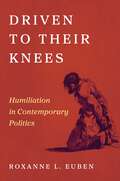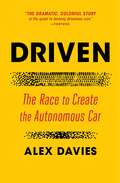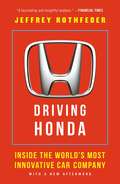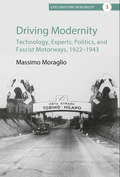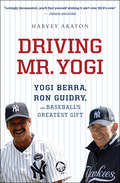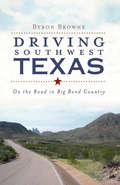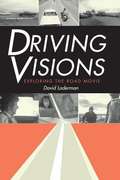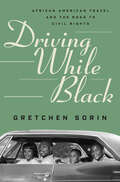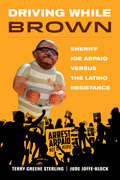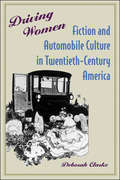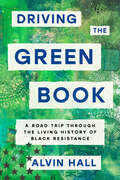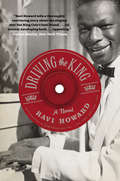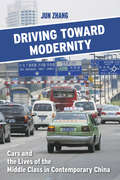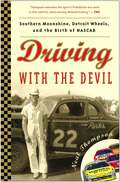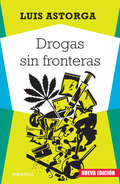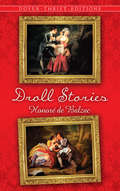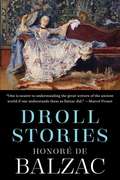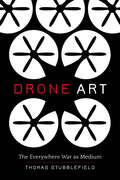- Table View
- List View
Driven Patriot
by Douglas Brinkley Townsend HoopesA biography of the brilliant, ambitious Forrestal whose career took him from the Wall Street to Washington.
Driven West
by A. J. LangguthBy the acclaimed author of the classic Patriots and Union 1812, this major work of narrative history portrays four of the most turbulent decades in the growth of the American nation. After the War of 1812, President Andrew Jackson and his successors led the country to its manifest destiny across the continent. But that expansion unleashed new regional hostilities that led inexorably to Civil War. The earliest victims were the Cherokees and other tribes of the southeast who had lived and prospered for centuries on land that became Alabama, Mississippi, and Georgia. Jackson, who had first gained fame as an Indian fighter, decreed that the Cherokees be forcibly removed from their rich cotton fields to make way for an exploding white population. His policy set off angry debates in Congress and protests from such celebrated Northern writers as Ralph Waldo Emerson. Southern slave owners saw that defense of the Cherokees as linked to a growing abolitionist movement. They understood that the protests would not end with protecting a few Indian tribes. Langguth tells the dramatic story of the desperate fate of the Cherokees as they were driven out of Georgia at bayonet point by U.S. Army forces led by General Winfield Scott. At the center of the story are the American statesmen of the day--Henry Clay, John Quincy Adams, John C. Calhoun--and those Cherokee leaders who tried to save their people--Major Ridge, John Ridge, Elias Boudinot, and John Ross. Driven West presents wrenching firsthand accounts of the forced march across the Mississippi along a path of misery and death that the Cherokees called the Trail of Tears. Survivors reached the distant Oklahoma territory that Jackson had marked out for them, only to find that the bloodiest days of their ordeal still awaited them. In time, the fierce national collision set off by Jackson's Indian policy would encompass the Mexican War, the bloody frontier wars over the expansion of slavery, the doctrines of nullification and secession, and, finally, the Civil War itself. In his masterly narrative of this saga, Langguth captures the idealism and betrayals of headstrong leaders as they steered a raw and vibrant nation in the rush to its destiny.
Driven With the Wind (Cheney Duvall, M. D. #8)
by Gilbert Morris Lynn MorrisWill Shiloh lose the Winslow fortune--and Cheney's love as well? After years of growing friendship, Shiloh Irons-Winslow believes he finally has something to offer Cheney Duvall and asks for her hand in marriage. But for Cheney, one insurmountable obstacle stands in the way of their happiness, and it is impossible to ignore. Devastated that she has allowed herself to fall so deeply and completely in love with Shiloh, Cheney faces the most difficult decision of her life. Whatever she decides, her momentary bliss is likely to end in heartache.
Driven by Fear: Epidemics and Isolation in San Francisco's House of Pestilence (History of Emotions)
by Guenter B RisseFrom the late nineteenth century until the 1920s, authorities required San Francisco's Pesthouse to segregate the diseased from the rest of the city. Although the Pesthouse stood out of sight and largely out of mind, it existed at a vital nexus of civic life where issues of medicine, race, class, environment, morality, and citizenship entwined and played out. Guenter B. Risse places this forgotten institution within an emotional climate dominated by widespread public dread and disgust. In Driven by Fear , he analyzes the unique form of stigma generated by San Franciscans. Emotional states like xenophobia and racism played a part. Yet the phenomenon also included competing medical paradigms and unique economic needs that encouraged authorities to protect the city's reputation as a haven of health restoration. As Risse argues, public health history requires an understanding of irrational as well as rational motives. To that end he delves into the spectrum of emotions that drove extreme measures like segregation and isolation and fed psychological, ideological, and pragmatic urges to scapegoat and stereotype victims--particularly Chinese victims--of smallpox, leprosy, plague, and syphilis. Filling a significant gap in contemporary scholarship, Driven by Fear looks at the past to offer critical lessons for our age of bioterror threats and emerging infectious diseases.
Driven to Their Knees: Humiliation in Contemporary Politics
by Roxanne L. EubenHow the rhetoric of humiliation defines the powerful and the powerless in modern politicsHumiliation pervades our politics, from images of stripped Palestinian men in Gaza to mocking chants at MAGA rallies. It suffuses pictures and videos, speaks through bodies as well as words, and is expressed by those with too much power as well as by those with too little. In Driven to Their Knees, Roxanne Euben takes readers from conflicts in the Arabic-speaking world to America&’s divided public square, advancing a theory of humiliation rooted in the ways people articulate and enact it. Euben analyzes some of the most conspicuous yet least studied Arabic expressions of humiliation, drawing on sources ranging from Qurʾānic commentary by Islamists to videos, poetry, songs, and tweets from the 2011 Egyptian revolution.Driven to Their Knees reveals what the language of humiliation says—and also how it works. This groundbreaking book shows how humiliation expresses the imposition of impotence by those with undeserved power, and the way it converts relations of power into crises of virility. Humiliation rhetoric defines both the humiliated and the humiliator and issues an urgent call for a remedy in the viscerally charged language of emasculation. For Donald Trump and Usama bin Laden alike, this means driving their enemy to his knees for all to see, and then boasting about it to compound the degradation. But for others, humiliation galvanizes their struggle to &“stand erect,&” uniting them in a refusal to be bowed low. Humiliation is not just about power but is itself a powerful language that does far more than reflect contemporary politics. The language of humiliation remakes the very world in which we live.
Driven: The Race to Create the Autonomous Car
by Alex DaviesAlex Davies tells the &“illuminating and important narrative&” (Steven Levy, author of Facebook: The Inside Story) of the quest to develop driverless cars—and the fierce competition between Google, Uber, and other companies in a race to revolutionize our lives.The self-driving car has been one of the most vaunted technological breakthroughs of recent years. But early promises that these autonomous vehicles would soon be on the roads have proven premature. Alex Davies follows the twists and turns of the story from its origins to today. The story starts with the Defense Advanced Research Projects Agency (DARPA), which was charged with developing a land-based equivalent to the drone, a vehicle that could operate in war zones without risking human lives. DARPA issued a series of three &“Grand Challenges&” that attracted visionaries, many of them students and amateurs, who took the technology from Jetsons-style fantasy to near-reality. The young stars of the Challenges soon connected with Silicon Valley giants Google and Uber, intent on delivering a new way of driving to the civilian world. Soon the automakers joined the quest, some on their own, others in partnership with the tech titans. But as road testing progressed, it became clear that the challenges of driving a car without human assistance were more formidable than anticipated. Davies profiles the industry&’s key players from the early enthusiasm of the DARPA days to their growing awareness that while this spin on artificial intelligence isn&’t yet ready for rush-hour traffic, driverless cars are poised to remake how the world moves. Driven explores &“the epic tale of competition and comradery, long odds and underdogs, all in service of a world-changing moonshot&” (Andy Greenberg, author of Sandworm: A New Era of Cyberwar).
Driving Honda
by Jeffrey RothfederFor decades there have been two iconic Japanese auto companies. One has been endlessly studied and written about. The other has been generally underappreciated and misunderstood. Until now. Since its birth as a motorcycle company in 1949, Honda has steadily grown into the world's fifth largest automaker and top engine manufacturer, as well as one of the most beloved, most profitable, and most consistently innovative multinational corporations. What drives the company that keeps creating and improving award-winning and bestselling models like the Civic, Accord, Odyssey, CR-V, and Pilot? According to Jeffrey Rothfeder, what truly distinguishes Honda from its competitors, especially archrival Toyota, is a deep commitment to a set of unorthodox management tenets. The Honda Way, as insiders call it, is notable for decentralization over corporate control, simplicity over complexity, experimentation over Six Sigma-driven efficiency, and unyielding cynicism toward the status quo and whatever is assumed to be the truth. Honda believes in freely borrowing from the past as a bridge to "innovative discontinuity" in the present. And those are just a few of the ideas that the company's colorful founder, Soichiro Honda, embedded in the DNA of his start-up sixty-five years ago. As the first journalist allowed behind Honda's infamously private doors, Rothfeder interviewed dozens of executives, engineers, and frontline employees about its management practices and global strategy. He shows how the company has developed and maintained its unmatched culture of innovation, resilience, and flexibility--and how it exported that culture to other countries that are strikingly different from Japan, establishing locally controlled operations in each region where it lays down roots. For instance, Rothfeder reports on life at a Honda factory in the tiny town of Lincoln, Alabama, and what happened when American workers were trained to follow the Honda Way, as a self-sufficient outpost of the global company. Could they master Honda's three core principles: Embrace Paradox: Honda encourages respectful disagreement and debate between opposing viewpoints, on matters large and small. New ideas often emerge from conflict. Real Place, Real Part, Real Knowledge: Honda teaches people to argue using facts, not assumptions. One must go to the factory floor, the showroom, the parking lot, the driver's seat, or the truck bed--whatever it takes--to get the facts and make a decision that can be supported with data. Respect Individualism: Honda often hires people with unusual backgrounds and independent streaks. It promotes those who question the status quo and who would probably struggle in organizations that focus on rigid rules and systems. Rothfeder shows how the Alabama plant became a new model for manufacturing in America. It can turn out several different types of cars on any given day and up to 300,000 vehicles and engines a year. Its flexible model enables unparalleled responsiveness to market changes and recovery from mistakes. As Soichiro Honda himself liked to say, "Success can be achieved only through repeated failure and introspection. In fact, success represents one percent of your work, which results only from the ninety-nine percent that is called failure."
Driving Honda
by Jeffrey RothfederSince its birth as a motorcycle company in 1949, Honda has steadily grown into one of the world's largest automakers and engine manufacturers, as well as one of the most beloved, most profitable, and most consistently innovative multinational corporations. What drives the company that keeps creating and improving award-winning and bestselling models like the Civic, Accord, Odyssey, CR-V, and Pilot?According to Jeffrey Rothfeder, what truly distinguishes Honda from its competitors, especially archrival Toyota, is a deep commitment to a set of unorthodox management tenets. The Honda Way, as insiders call it, is notable for decentralization over corporate control, simplicity over complexity, experimentation over Six Sigma-driven efficiency, and unyielding cynicism toward the status quo and whatever is assumed to be the truth. Those are just a few of the ideas that the company's colorful founder Soichiro Honda embedded in the DNA of his start-up sixty-five years ago.As the first journalist allowed behind Honda's infamously private doors, Rothfeder interviewed dozens of executives, engineers, and frontline employees about Honda's management practices and global strategy. He shows how the company developed and maintained its unmatched culture of innovation, resilience, and flexibility--and how it exported that culture to other countries that are strikingly different from Japan, establishing locally controlled operations in each region where it lays down roots.From the Trade Paperback edition.nciples:Embrace Paradox: Honda encourages respectful disagreement and debate between opposing viewpoints, on matters large and small. New ideas often emerge from conflict.Real Place, Real Part, Real Knowledge: Honda teaches people to argue using facts, not assumptions. One must go to the factory floor, the showroom, the parking lot, the driver's seat, or the truck bed--whatever it takes--to get the facts and make a decision that can be supported with data.Respect Individualism: Honda often hires people with unusual backgrounds and independent streaks. It promotes those who question the status quo and who would probably struggle in organizations that focus on rigid rules and systems.Rothfeder shows how the Alabama plant became a new model for manufacturing in America. It can turn out several different types of cars on any given day and up to 300,000 vehicles and engines a year. Its flexible model enables unparalleled responsiveness to market changes and recovery from mistakes. As Soichiro Honda himself liked to say, "Success can be achieved only through repeated failure and introspection. In fact, success represents one percent of your work, which results only from the ninety-nine percent that is called failure."
Driving Modernity: Technology, Experts, Politics, and Fascist Motorways, 1922-1943 (Explorations in Mobility #3)
by Massimo MoraglioOn March 26th, 1923, in a formal ceremony, construction of the Milan–Alpine Lakes autostrada officially began, the preliminary step toward what would become the first European motorway. That Benito Mussolini himself participated in the festivities indicates just how important the project was to Italian Fascism. Driving Modernity recounts the twisting fortunes of the autostrada, which-alongside railways, aviation, and other forms of mobility-Italian authorities hoped would spread an ideology of technological nationalism. It explains how Italy ultimately failed to realize its mammoth infrastructural vision, addressing the political and social conditions that made a coherent plan of development impossible.
Driving Mr. Yogi: Yogi Berra, Ron Guidry, and Baseball's Greatest Gift
by Harvey Araton&“A warm, sentimental look at a baseball icon&” (The Tampa Tribune). Driving Mr. Yogi is the story of a unique friendship between two New York Yankees legends—a pitcher and catcher—who share rides, meals, and a bond that transcends the twenty-five-year difference in their ages. The story begins in 1999, when Hall of Famer Yogi Berra is reunited with the Yankees after a long self-exile, the result of being unceremoniously fired by team owner George Steinbrenner fourteen years before. A reconciliation between Berra and the boss means that Berra will once again attend spring training. Retired-pitcher-turned-pitching-coach Ron Guidry knows the club&’s young players will benefit from &“Mr. Yogi&’s&” encyclopedic knowledge of the game, just as Guidry had during his playing days, so he encourages his old mentor to share his insights. In Yogi, Guidry finds not just a personable dinner companion or source of amusement—he finds a best friend. At turns tender and laugh-out-loud funny, and teeming with unforgettable baseball yarns that span more than fifty years, Driving Mr. Yogi is a universal story about the importance of wisdom being passed from one generation to the next, as well as a reminder that time is what we make of it and compassion never gets old. &“Funny, revealing, and surprising . . . Anything that brings new Yogi Berra stories is a good book.&” —MLB.com &“Lovingly documented . . . You&’ll find yourself wishing it ain&’t over till it&’s over.&” —Parade magazine
Driving Southwest Texas: On the Road in Big Bend Country (History & Guide)
by Byron BrowneWest of Austin lies Big Bend Country. A region of rich history that still resembles the old frontier, Southwest Texas epitomizes the mystique and allure of this grand state. From the sweeping desert vistas to the canyons of Big Bend National Park, the geography itself is nothing short of incredible. Whether it's discovering historic Fort Davis, sharing in Annie Riggs's legacy or watching the Marfa Lights, a treasure awaits every traveler in this land. Join historian and travel writer Byron Browne as he and his wife, Angie, explore the sights and stories of this unique and charming piece of the Lone Star State
Driving Terror: Labor, Violence, and Justice in Cold War Argentina (Diálogos Series)
by Karen RobertDriving Terror tells the story of twenty-four Ford autoworkers in Argentina who were tortured and &“disappeared&” for their union activism in 1976, miraculously survived, and pursued a decades-long quest for truth and justice. In December 2018, more than four decades after their ordeal, the men won a historic human-rights case against a military commander and two retired Ford Argentina executives who were convicted of crimes against humanity.The book uses this David-and-Goliath story to explore issues of labor repression and corporate complicity with Argentina&’s last military dictatorship as well as to shed light on the enormous obstacles facing victims of such crimes. Its emphasis on working-class activism in the arenas of labor and human rights introduces North American readers to a new narrative of contemporary Argentine history.The Ford survivors&’ story intertwines with the symbolic evolution of the car the men helped build at Ford: the Falcon sedan. The political polarization and violence of the Cold War era transformed the Falcon from a popular family car to a tool of state terror after the coup of 1976, when it became associated with the widespread practice of &“disappearance.&” Its meaning continued to evolve after the return to democracy, when artists and activists used it as a symbol of military impunity during Argentina&’s long-term struggles over justice and memory.
Driving Visions
by David Laderman"This is a superbly conceived, thoughtfully organized, and well-written study of a subject--the 'road movie'--that has lacked anything close to a coherent, book-length overview. . . . It will make an ideal course text and should also have a wide appeal to non-academic readers. "-- Scott Simmon, author of The Films of D. W. Griffith and King Vidor, AmericanFrom the visionary rebellion of Easy Rider to the reinvention of home in The Straight Story, the road movie has emerged as a significant film genre since the late 1960s, able to cut across a wide variety of film styles and contexts. Yet, within the variety, a certain generic core remains constant: the journey as cultural critique, as exploration beyond society and within oneself. This book traces the generic evolution of the road movie with respect to its diverse presentations, emphasizing it as an "independent genre" that attempts to incorporate marginality and subversion on many levels. David Laderman begins by identifying the road movie's defining features and by establishing the literary, classical Hollywood, and 1950s highway culture antecedents that formatively influenced it. He then traces the historical and aesthetic evolution of the road movie decade by decade through detailed and lively discussions of key films. Laderman concludes with a look at the European road movie, from the late 1950s auteurs through Godard and Wenders, and at compelling feminist road movies of the 1980s and 1990s.
Driving While Black: African American Travel And The Road To Civil Rights
by Gretchen SorinBloomberg • Best Nonfiction Books of 2020: "[A] tour de force." The basis of a major PBS documentary by Ric Burns, this “excellent history” (The New Yorker) reveals how the automobile fundamentally changed African American life. Driving While Black demonstrates that the car—the ultimate symbol of independence and possibility—has always held particular importance for African Americans, allowing black families to evade the dangers presented by an entrenched racist society and to enjoy, in some measure, the freedom of the open road. Melding new archival research with her family’s story, Gretchen Sorin recovers a lost history, demonstrating how, when combined with black travel guides—including the famous Green Book—the automobile encouraged a new way of resisting oppression.
Driving While Brown: Sheriff Joe Arpaio versus the Latino Resistance
by Terry Greene Sterling Jude Joffe-BlockHow Latino activists brought down powerful Arizona sheriff Joe ArpaioJournalists Terry Greene Sterling and Jude Joffe-Block spent years chronicling the human consequences of Sheriff Joe Arpaio’s relentless immigration enforcement in Maricopa County, Arizona. In Driving While Brown, they tell the tale of two opposing movements that redefined Arizona’s political landscape—the restrictionist cause embraced by Arpaio and the Latino-led resistance that rose up against it.The story follows Arpaio, his supporters, and his adversaries, including Lydia Guzman, who gathered evidence for a racial-profiling lawsuit that took surprising turns. Guzman joined a coalition determined to stop Arpaio, reform unconstitutional policing, and fight for Latino civil rights. Driving While Brown details Arpaio's transformation—from "America’s Toughest Sheriff," who forced inmates to wear pink underwear, into the nation’s most feared immigration enforcer who ended up receiving President Donald Trump’s first pardon. The authors immerse readers in the lives of people on both sides of the battle and uncover the deep roots of the Trump administration's immigration policies.The result of tireless investigative reporting, this powerful book provides critical insights into effective resistance to institutionalized racism and the community organizing that helped transform Arizona from a conservative stronghold into a battleground state.
Driving Women: Fiction and Automobile Culture in Twentieth-Century America
by Deborah ClarkeOver the years, cars have helped to define the experiences and self-perceptions of women in complex and sometimes unexpected ways. When women take the wheel, family structure and public space are reconfigured and re-gendered, creating a context for a literary tradition in which the car has served as a substitute for, an escape from, and an extension of the home, as well as a surrogate mother, a financial safeguard, and a means of self-expression.Driving Women examines the intersection of American fiction—primarily but not exclusively by women—and automobile culture. Deborah Clarke argues that issues critical to twentieth-century American society—technology, mobility, domesticity, and agency—are repeatedly articulated through women's relationships with cars. Women writers took surprisingly intense interest in car culture and its import for modern life, as the car, replete with material and symbolic meaning, recast literal and literary female power in the automotive age. Clarke draws on a wide range of literary works, both canonical and popular, to document women's fascination with cars from many perspectives: historical, psychological, economic, ethnic. Authors discussed include Wharton, Stein, Faulkner, O’Connor, Morrison, Erdrich, Mason, Kingsolver, Lopez, Kadohata, Smiley, Senna, Viramontes, Allison, and Silko. By investigating how cars can function as female space, reflect female identity, and reshape female agency, this engaging study opens up new angles from which to approach fiction by and about women and traces new directions in the intersection of literature, technology, and gender.
Driving the Green Book: A Road Trip Through the Living History of Black Resistance
by Alvin HallJoin award-winning broadcaster Alvin Hall on a journey through America’s haunted racial past, with the legendary Green Book as your guide.For countless Americans, the open road has long been a place where dangers lurk. In the era of Jim Crow, Black travelers encountered locked doors, hostile police, and potentially violent encounters almost everywhere, in both the South and the North. From 1936 to 1967, millions relied on The Negro Motorist Green Book, the definitive guide to businesses where they could safely rest, eat, or sleep. Most Americans only know of the guide from the 2018 Green Book movie or the 2020 Lovecraft Country TV show. Alvin Hall set out to revisit the world of the Green Book to instruct us all on the real history of the guide that saved many lives. With his friend Janée Woods Weber, he drove from New York to Detroit to New Orleans, visiting motels, restaurants, shops, and stores where Black Americans once found a friendly welcome. They explored historical and cultural landmarks, from the theatres and clubs where stars like Duke Ellington and Lena Horne performed to the Lorraine Motel where Dr. Martin Luther King, Jr. was assassinated. Along the way, they gathered memories from some of the last living witnesses for whom the Green Book meant survival—remarkable people who not only endured but rose above the hate, building vibrant Black communities against incredible odds.Driving the Green Book is a vital work of national history as well as a hopeful chronicle of Black resilience and resistance.The book contains 25 outstanding black and white photos and ephemera.
Driving the King: A Novel
by Ravi HowardMontgomery, Alabama, December 1945. War hero Nat Weary has returned to his hometown, eager to rebuild his life. His childhood friend, the famous Nat King Cole, is also home for a rare performance. During the concert, Weary plans to propose to his sweetheart, and Cole will serenade them with a song.But Weary’s dreams for the future are destroyed when a white man, armed with a pipe, rushes the stage. Leaping from the audience, the former soldier stops the assailant—an act of bravery that leads to ten years of hard labor in prison.Free at last a decade later, Weary heads to Los Angeles to work for his old friend. It is the promise of a new life removed from the violence and degradation of Jim Crow Alabama. But he discovers that even in the City of Angels, wealth, popularity, and talent cannot protect a black man from discrimination and hate.Drawn back to Montgomery to lay some unfinished business to rest, Cole and Weary discover a city in the midst of change. A woman named Rosa Parks has inspired blacks to boycott the city’s buses—a daring fight for dignity and rights that will eventually grip the entire nation.“A moving tale about bigotry and the power of friendship.” —People“Heartbreaking. . . . A bold reimagining of [the] civil rights era.” —Los Angeles Times
Driving toward Modernity: Cars and the Lives of the Middle Class in Contemporary China
by Jun ZhangIn Driving toward Modernity, Jun Zhang ethnographically explores the entanglement between the rise of the automotive regime and emergence of the middle class in South China. Focusing on the Pearl River Delta, one of the nation's wealthiest regions, Zhang shows how private cars have shaped everyday middle-class sociality, solidarity, and subjectivity, and how the automotive regime has helped make the new middle classes of the PRC. By carefully analyzing how physical and social mobility intertwines, Driving toward Modernity paints a nuanced picture of modern Chinese life, comprising the continuity and rupture as well as the structure and agency of China's great transformation.
Driving with the Devil: Southern Moonshine, Detroit Wheels, and the Birth of NASCAR
by Neal ThompsonTodays NASCAR is a family sport with 75 million loyal fans, which is growing bigger and more mainstream by the day. Part Disney, part Vegas, part Barnum & Bailey, NASCAR is also a multibillion-dollar business and a cultural phenomenon that transcends geography, class, and gender. But dark secrets lurk in NASCAR's past. Driving with the Devil uncovers for the first time the true story behind NASCAR's distant, moonshine-fueled origins and paints a rich portrait of the colorful men who created it. Long before the sport of stock-car racing even existed, young men in the rural, Depression-wracked South had figured out that cars and speed were tickets to a better life. With few options beyond the farm or factory, the best chance of escape was running moonshine. Bootlegging offered speed, adventure, and wads of cash if the drivers survived. Driving with the Devil is the story of bootleggers whose empires grew during Prohibition and continued to thrive well after Repeal, and of drivers who thundered down dusty back roads with moonshine deliveries, deftly outrunning federal agents. The car of choice was the Ford V-8, the hottest car of the 1930s, and ace mechanics tinkered with them until they could fly across mountain roads at 100 miles an hour. After fighting in World War II, moonshiners transferred their skills to the rough, red-dirt racetracks of Dixie, and a national sport was born. In this dynamic era (1930s and 40s), three men with a passion for Ford V-8s convicted criminal Ray Parks, foul-mouthed mechanic Red Vogt, and crippled war veteran Red Byron, NASCAR's first champion emerged as the first stock car team. Theirs is the violent, poignant story of how moonshine and fast cars merged to create a new sport for the South to call its own. Driving with the Devil is a fascinating look at the well-hidden historical connection between whiskey running and stock-car racing.
Drogas sin fronteras
by Luis AstorgaLos expedientes de una guerra permanente.Más de diez años después de su primera edición, este libro se revela como un clásico fundamental para comprender el proceso histórico que derivó en la llamada "guerra contra las drogas".Drogas sin fronteras describe la relación entre México y Estados Unidos sobre el narcotráfico durante el periodo que va de 1916 a 1970.La investigación de Luis Astorga, basada en el monumental acervo de los Archivos Nacionales de College Park, Maryland, reafirma su vigencia en el marco de una potencial reorientación de la política de seguridad y drogas del gobierno mexicano, cuyos alcances siempre han estado dramáticamente subordinados a los intereses de Estados Unidos en la agenda binacional.El libro, que abarca las primeras seis décadas del siglo XX, muestra las condiciones que hicieron posible la consolidación de un esquema prohibicionista de ciertas drogas en México, así como los argumentos, prejuicios, mitos y chantajes diplomáticos que lo fundamentaron. Es un referente para entender mejor el proceso de sedimentación jurídica, social y psicológica de categorías y esquemas de percepción sobre algunas sustancias psicoactivas y sobre quienes se dedican a producirlas, comercializarlas y consumirlas.Seguir los lineamientos impuestos por Estados Unidos y actuar convencidos de que son los mejores, sin margen para una política independiente, o sin un consenso internacional previo, ha llevado a México a un callejón sin salida con costos sociales, económicos, políticos y culturales muy altos. ¿Un siglo de fracasos no es suficiente para buscar y ensayar nuevas vías?
Droit et coutume en France aux XIIe et XIIIe siécles (Variorum Collected Studies)
by André GouronThis third volume by André Gouron brings together a widely scattered set of articles on Roman law in medieval France and its influence. The first group of papers is concerned with the medieval history of Roman law itself, while the two following sections look at how it contributed to the (perfectionnement) of canon law, on the one hand, and to the emergence of customary law on the other. As the author would see it, there are the three aspects of the inexorable advance, if not of a science, at least of a clear effort towards logical clarification, which revolutionised law in the 12th and 13th centuries, first in southern Europe, but soon in the west and north too. At the same time, these studies help reveal some of the complex network of intellectual links that underlay these developments.
Droll Stories (Dover Thrift Editions)
by Honore De BalzacBalzac's Contes Drolatiques, published in three installments in the 1830s, offers a lively and lusty portrait of sixteenth-century French life and manners. These thirty stories in the tradition of Boccaccio, Chaucer, and Rabelais were claimed by the author to have originated in manuscripts from the abbeys of Touraine. Abounding in episodes of good-humored licentiousness, the tales scandalized Balzac's contemporaries and continue to delight modern readers.French novelist and playwright Honoré de Balzac (1799-1850) was a founder of realism in European literature. An inspiration to Proust, Dickens, Faulkner, Dostoyevsky, and countless others, Balzac wrote works that were hailed for their multifaceted characters and exquisite attention to detail. This edition's excellent translation was the first to make Contes Drolatiques available to English-speaking readers.
Droll Stories: Collected From The Abbeys Of Touraine (Xist Classics Ser.)
by Honore BalzacFrom the great French novelist comes this long-unavailable collection of tales in the tradition of Boccaccio’s Decameron. Balzac’s Contes Drolatiques, or Droll Stories, were originally published in three volumes in the 1830s. Set in medieval Europe, these stories were Balzac’s attempt to write in the great tradition of Rabelais and Boccaccio, to render the Middle Ages with a touch of raunchy humor, and to provide a delightful portrait of medieval France. Balzac took the old themes that had delighted his ancestors--the tales of faithless wives and confiding husbands, of monks incredibly endowed for amorous athleticism, of lusty wenches and adventurous lads, and of great bouts of eating and drinking. Droll Stories has always been an essential part of Balzac’s work when published in French, but it has been excluded from the definitive English editions. This book presents all three volumes of this classic and enduring work.
Drone Art: The Everywhere War as Medium
by Thomas StubblefieldWhat happens when a drone enters a gallery or appears on screen? What thresholds are crossed as this weapon of war occupies everyday visual culture? These questions have appeared with increasing regularity since the advent of the War on Terror, when drones began migrating into civilian platforms of film, photography, installation, sculpture, performance art, and theater. In this groundbreaking study, Thomas Stubblefield attempts not only to define the emerging genre of "drone art" but to outline its primary features, identify its historical lineages, and assess its political aspirations. Richly detailed and politically salient, this book is the first comprehensive analysis of the intersections between drones, art, technology, and power.




